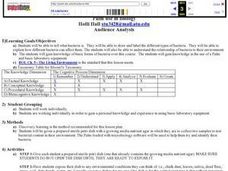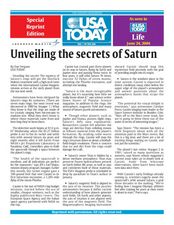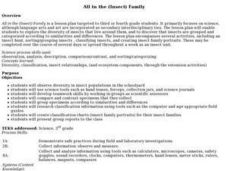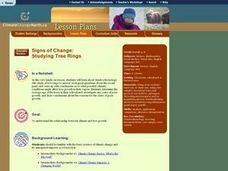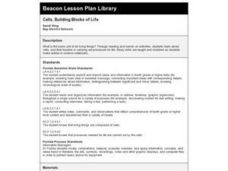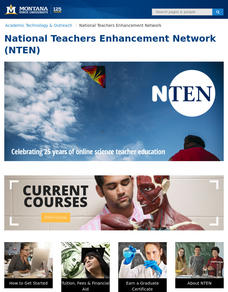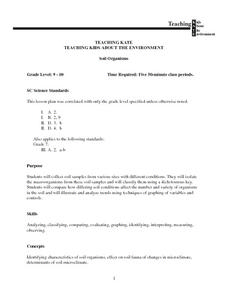Curated OER
Mussel Movements
Students consider the impact of invasive species on local environments. In this ecology lesson, watch the video, Arizona Wildlife Views, which focuses on invasive species. Students develop vocabulary, relate to meaningful comprehension...
Curated OER
CSI Clamshell Investigation
Students explore predator/prey relationships. They research information on moon snails and claims. Students draw conclusions from the data collected. They use math and graphing to determine if there is a relationship to the clam's size...
Curated OER
Convection Currents
Students explain and understand the circulation of air in the atmosphere. They identify that energy can be carried from one place to another by heat flow or by waves, including water, light and sound waves, or by moving objects. ...
Curated OER
Peeled Trees Tell The Story
Students investigate the diversity of life that is found in Montana. They research some of the different interactions that organisms have with their environment. The lesson plan includes an extensive introduction for teacher information....
Curated OER
Palm Use in Biology
Young scholars view bacteria through a microscope. They draw and label the bacteria using microbiology software loaded onto their Palms.
Curated OER
Powdery Mildew Fungi: Classification and Ecology
Pupils use a written key or illustrated key to identify fungi on plant leaves into its genus based on sexual or asexual reproduction, host range diversity, and host-parasite relationships.
Curated OER
Unveiling the Secrets of Saturn
Students read and study an article then answer questions on Saturn. In this investigative lesson students identify ways space exploration has helped humanity and then they search the Internet for space pictures and sketch a drawing of...
Curated OER
You've Got to Be Cool to Make Igneous Rocks
Students describe how igneous rocks are formed, design a classification system to group igneous rocks and develop a controlled experiment to prove that the rate of cooling affects the size of the crystals.
Curated OER
All in the (Insect) Family
Students participate in a series of activities in order to explore the diversity of insects. They explore how insects are grouped and categorized.
Curated OER
Plant and Animal Cells
Students investigate the difference between plant and animal cells. They observe a variety o plant and animals cells by looking at a piece of cork, an onion, elodea, prepared slides of paramecium, human bone, frog blood, and human...
Curated OER
Deep Freeze
Students practice various sampling methods for retrieving data under water, ice, and soil. They use the sample material to make temperature measurements, chart contents, and draw their own conclusions as to what is happening in the...
Curated OER
A Variety of Very Safe Veggies
Learners study viruses and bacteria that can contaminate vegetables. They examine how vegetables can be preserved and what farmers might do to keep vegetables safe. They examine with pickling as a way to keep vegetable preserved safely.
Curated OER
Magnify It!
Learners view objects of various sizes from several viewing distances to discover that their visual field is limited. They record what they see and compare their observations with classmates. They conduct more structured experiments.
Curated OER
Breaking News English: Mobile Phone Charges for Ringtones
For this mobile phone charges for ringtones worksheet, students read the article, answer true and false questions, complete synonym matching, complete phrase matching, complete a gap fill, answer short answer questions, answer discussion...
Curated OER
Signs of Change: Tree Rings
Students identify and experiment with dendrochronology (the study of tree rings to answer ecological questions about the recent past) and come up with conclusions as to what possible climatic conditions might affect tree growth in their...
Curated OER
The Strength of the Muscular System
Seventh graders investigate the strength of the muscular system. They explore voluntary and involuntary muscle movement and discuss the types of muscles: cardiac or heart, skeletal, and smooth. They visit stations to answer questions...
Curated OER
Cells, Building Blocks of Life
Fourth graders, in groups, explore cells, the basic unit of all living things.
Curated OER
Organizing Organs
Fifth graders research plant and animals cells and create a Venn Diagram to show the similarities and differences.
Curated OER
Magnify It!
Learners explain that there are limits to what the eye can see and that a magnifying glass can help extend those limits. They examine an object with the magnifying glass and draw the size and shape of what they see as accurately as they...
Curated OER
Body Organization
Seventh graders explore how the body is organized. They create flashcards of key terms and visit stations to view levels of organization in the human body. They examine themselves and rearrange their flashcards in order of increasing...
Curated OER
Life in Streams and Ponds
Students collect microorganisms, demonstrate correct laboratory/Gram stain procedure, and design and construct tables to organize data.
Curated OER
Soil Organisms
Young scholars work together to collect soil samples from different locations. In the samples, they identify the macroorganisms and classify them. They identify the conditions that affect how macroorganisms grow. They also analyze and...
Curated OER
Why is a salt marsh important?
Middle schoolers discuss the salt marsh. They define the following terms: habitat, water, land and air. Students work in small groups. They are asked why are they going to a salt marsh? Middle schoolers discuss whose habitat is it at...
Curated OER
Ocean Voyage Scavenger Hunt
In this ocean voyage worksheet, students utilize the Internet to access one specific website to find the answers to five short answer questions about oceans.






